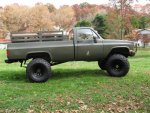91W350
Well-known member
- 4,415
- 60
- 48
- Location
- Salina, Kansas
The civilian 6.2 was governed at 3600. It was designed in the early 80's as a light duty diesel to replace the sorry Oldsmobile 350 gasoline engine that GM had previously converted to diesel. The engine was not designed to be a powerhouse, they were looking for a fuel mileage altenative to gasoline. To that end they were pretty successful and it is not hard to find 1/2 ton Suburbans and Blazers that with the overdrive transmission ran over 300,000 miles. Some of the guys that were running the 6.2 back nin the day in 2wd Suburbans and 2wd pickups would get mid to upper 20s for fuel economy. That is cheap running down the highway fuel mileage.
The guys that ordered them in their one ton trucks were not nearly as happy with them. The lower gear ratios made them run at a much higher rpm. Those guys fought oil leaks, rods through the sides of the block, tired engines, broken or cracked blocks in the main bearing web area and most of those trucks got new engines or were converted to gasoline before they hit 100,000 miles.
I have read that the military version is governed at 4000 or 4400 and these engines will do that for a short period, but if you want yours to survive, I would recommend running it at a reasonable rpm range of less than 2600. We are not talking about a Cummin 4BT or 6BT here. These engines were great as a light duty engine at a low rpm, happily churning away running 65 to 75 mph pulling a high geared Suburban or pickup with some guy's bass boat tied on. They were not so happy turning 3,000 rpm running 70 mph in a low geared 1 ton truck pulling a construction trailer.
A lot of the local racers bought one ton dually pickups with the 6.2 to pull their race trailers. They liked the fuel mileage, they were disappointed on the power, and they scattered them before they made 100,000 miles. The common fix was normally a large cubic inch small block Chevy that could stand the rpm. In rural Kansas you can still find civilian pickups parked with bad 6.2 diesels in them.
You can run your 6.2 diesel on the governor all day long if you want to, it is your truck and you pay the bills. I am just trying to keep some new guy from thinking this is the answer to his search for a solid off road truck that can easy run 80 mph with a taller set of tires. These engines will not live running on the governor like a lot of other diesels will. Glen
The guys that ordered them in their one ton trucks were not nearly as happy with them. The lower gear ratios made them run at a much higher rpm. Those guys fought oil leaks, rods through the sides of the block, tired engines, broken or cracked blocks in the main bearing web area and most of those trucks got new engines or were converted to gasoline before they hit 100,000 miles.
I have read that the military version is governed at 4000 or 4400 and these engines will do that for a short period, but if you want yours to survive, I would recommend running it at a reasonable rpm range of less than 2600. We are not talking about a Cummin 4BT or 6BT here. These engines were great as a light duty engine at a low rpm, happily churning away running 65 to 75 mph pulling a high geared Suburban or pickup with some guy's bass boat tied on. They were not so happy turning 3,000 rpm running 70 mph in a low geared 1 ton truck pulling a construction trailer.
A lot of the local racers bought one ton dually pickups with the 6.2 to pull their race trailers. They liked the fuel mileage, they were disappointed on the power, and they scattered them before they made 100,000 miles. The common fix was normally a large cubic inch small block Chevy that could stand the rpm. In rural Kansas you can still find civilian pickups parked with bad 6.2 diesels in them.
You can run your 6.2 diesel on the governor all day long if you want to, it is your truck and you pay the bills. I am just trying to keep some new guy from thinking this is the answer to his search for a solid off road truck that can easy run 80 mph with a taller set of tires. These engines will not live running on the governor like a lot of other diesels will. Glen
Last edited:



